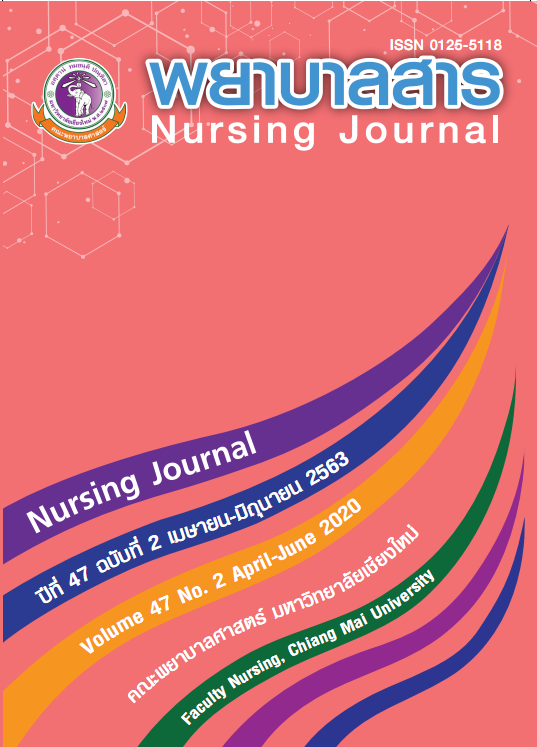Development of a Competency Framework Among Gastrointestinal Endoscopy Nurses, Ramkhamhaeng Hospital Group, Chiang Mai Province
Keywords:
Competency Framework, Gastrointestinal Endoscopy Nurses, Ramkhamhaeng Hospital GroupAbstract
Nurses’ competency is important to the quality of nursing service. The development of a competency framework is needed for effective human resource management. This developmental study aimed to develop a competency framework for gastrointestinal endoscopy nurses at Ramkhamhaeng Hospital Group, Chiang Mai Province, by applying the competency framework development model by Marrelli, Tondora, and Hoge (2005). The participants selected by using purposive sampling consisted of nine gastrointestinal endoscopy nurses and three head nurses and executive nurse. The instrument was interview guidelines that were verified the clarity, appropriateness, and sequence of questions from experts. Data collection methods included reviewing literature and interviews with gastrointestinal endoscopy nurses. Data were analyzed by using content analysis, content validity index of each individual item, and descriptive statistic.
The results revealed that the competency framework of gastrointestinal endoscopy nurses at Ramkhamhaeng Hospital Group, Chiang Mai Province consisted of six competencies and eighty-two behavioral indicators including: 1) care before gastrointestinal endoscopy (14 behavioral indicators, 2) care during gastrointestinal endoscopy (14 behavioral indicators), 3) care after gastro intestinal endoscopy (11 behavioral indicators), 4) assistance to physicians in gastrointestinal endoscopy (14 behavioral indicators), 5) record of documents related to gastrointestinal endoscopy (13 behavioral indicators), and 6) maintenance of gastrointestinal endoscopy tools and equipment (16 behavioral indicators). Nurse administrators at Ramkhamhaeng Hospital Group, Chiang Mai Province can use this competency framework to develop the competency assessment form and to use as guidelines for the recruitment, orientation, and development of gastrointestinal endoscopy nurses.
References
Aowpitaya, B. (2004). Gastrointestinal Endoscopy room. In T. Ratanachuake, D. Selaruk, W. Srisabai, L. Tetmasa, & P. Jiwapaisarnpong (Eds.). Gastrointestinal Endoscopy for Endoscopy Nurses. (1 st ed., pp. 1-12). Bangkok: KR. (In Thai)
Chaiwat, R. (2004). Monitor care during and post gastrointestinal endoscopy. In T. Ratanachuake,D. Selaruk, W. Srisabai, L. Tetmasa, & P. Jiwapaisarnpong (Eds.). Gastrointestinal Endoscopy for Endoscopy Nurses. (1 st ed., pp. 64-73). Bangkok: KR. (In Thai)
Chiangmai Ram Hospital. (2015). Self Assessment Report SAR2011. Chiangmai: Quality of nursing organization ChiangmaiRam Hospital. (In Thai)
Fey, M. K., & Miltner, R. S. (2000). A competency-based orientation program for new graduate nurses. Journal of Nursing Administration, 30(3), 126-32.
Harnsomboon, P. (2008). Complication of Endoscopy. In Rajvithi Hospital and The Endoscopy Nurse Society of Thailand. Academic annual conference 2008 Nursing quality improvement for gastrointestinal endoscopy (Safe and Save in GI Endoscopy Procedure). Bangkok: An introduction to publishing in education. (In Thai)
Kongdetsukda, C. (2015, October 4). Prevention Avoid risk and treatment for gastrointestinal cancer. Daily news. (In Thai)
Kongkasawat, T. (2008). How to use competency in the organization. Bangkok: Technology Promotion Association (thai-Japan). (In Thai)
Lohsiriwat, W. (2011). Bowel preparation for colonoscopy. In S. Pongprasobchai, T. Akarawiput,& A. Kachintorn (Eds.). Colonoendoscopy (1 st ed., pp38-52). Bangkok: Wetchasarn. (In Thai)
Marrelli A. F., Tondora J., & Hoge M. A. (2005). Strategies for developing competency model.Administration and Policy in mental Health, 32(5-6), 533-561. doi:10.1007/s10488-005-3264-0
Ministry of Public Health, Bureau of Information office. (2015). Thailand Public Health reveals that cancer kills 67,000 people a year and lost almost 80,000 m illion bath. Retrieved from http://www.pr.moph.go.th (In Thai)
Ministry of Public Health, Department of Medical Service, National Cancer Institute. (2013). National Cancer Control Programme (2013-2017). Bangkok: The Agricultural Cooperative Federation of Thailand Limited. (In Thai)
Nursing Organization of Chiangmai Ram Hospital. (2015). Self Assessment Report SAR2011. Chiangmai: Quality of nursing organization Chiangmai Ram Hospit al. (In Thai)
Office of the Permanent Secretary of Ministry of Public Health. (2015). Declaration of Patient’s Rights. Retrieved from www. tmc.or.th (In Thai)
Pinyopasakul, W., & Ratanalert, S. (2008). Discharge planning in Endoscopy Unit. (58-60). Academic annual conference 2008 Nursing quality improvement for gastrointestinal endoscopy (Safe and Save in GI Endoscopy Procedure). Bangkok: An introduction to publishing in education Rajvithi Hospital and The Endoscopy Nurse Society of Thailand. (In Thai)
Ratanachuake, T. (2010). Endoscopic Technique to Maximize the Diagnosis in Upper Gastrointestinal Bleeding. In S. Pongprasobchai, T. Akarawiput, & A. Kachintorn (Eds.). Bleeding in Gastrointestinal (1 st ed., pp46-54). Bangkok: Wetchasarn. (In Thai)
Sangchan, A. (2006). Practical Endoscopic Disinfection. In S. Triprasertsuk, R. Roeknimit, & Y. Satawattumrong (Eds.)., Practical GI Endoscopy 2 (2nd ed., pp. 23-36). Bangkok: Morchaoban. (In Thai)
Santong, N. (2004). Let’s know competency. Bangkok: HR center. (In Thai)
Society of Gastroenterology Nurses and Associates Incorporate. (2008). Gastroenterology Nursing:A core curriculum. Retrieved from http://www.sgna.org.
Spencer, L., & Spencer, S. M. (1993). Competency at work. New York: John Wiley & Sons.
Srisatitnarakul, B. (2007). The methodology in nursing research.(4th ed.). Bangkok: U&I Intermedia. (In Thai)
Subsamutchai, C., & Jukkapak, S. (2013). Post- Procedure Esopha geal Perforation. In S. Pongprasobchai, T. Akarawiput, S. Leelakusolwong, & C. Kositcha iwat (Eds.), Endoscopic Complications (1st ed., pp1-14). Bangkok: Wetchasarn. (In Thai)
Taylor, K. (2000). Tackling the issue of nurse competency. Nursing Management, 31 (9), 34-38.
Thameyasen, P. (2004). Cleaning and disinfection of flexible endoscope scope. In T. Ratanachuake, D. Selaruk, W. Srisabai, L. Tetmasa, & P. Jiwapaisarnpong (Eds.). Gastrointestinal Endoscopy for Endoscopy Nurses. (1st ed., pp. 74-88). Bangkok: KR. (In Thai)
Thantiwitayatan, K. (2004). Anesthesiology in Gastrointestinal Endoscopy. In T. Ratanachuake,D. Selaruk, W. Srisabai, L. Tetmasa, & P. Jiwapaisarnpong (Eds.). Gastrointestinal Endoscopy for Endoscopy Nurses. (1st ed., pp. 51-63). Bangkok: KR. (In Thai)
The Healthcare Accreditation Institute (Public Organization). ( 2010). Patient Safety Goals: SIMPLE (3rd ed.). Nonthaburi: Poramut. (In Thai)
Thungmunkong, P. (2008). New generation, highly effective disinfectant. Healthy GI for Healthy People. Bangkok: P.L.Living Co., Ltd. (In Thai)
Downloads
Published
How to Cite
Issue
Section
License
บทความที่ได้รับการตีพิมพ์เป็นลิขสิทธิ์ของวารสารพยาบาลสาร
ข้อความที่ปรากฏในบทความแต่ละเรื่องในวารสารวิชาการเล่มนี้เป็นความคิดเห็นส่วนตัวของผู้เขียนแต่ละท่านไม่เกี่ยวข้องกับมหาวิทยาลัยเชียงใหม่ และคณาจารย์ท่านอื่นๆในมหาวิทยาลัยฯ แต่อย่างใด ความรับผิดชอบองค์ประกอบทั้งหมดของบทความแต่ละเรื่องเป็นของผู้เขียนแต่ละท่าน หากมีความผิดพลาดใด ๆ ผู้เขียนแต่ละท่านจะรับผิดชอบบทความของตนเองแต่ผู้เดียว






